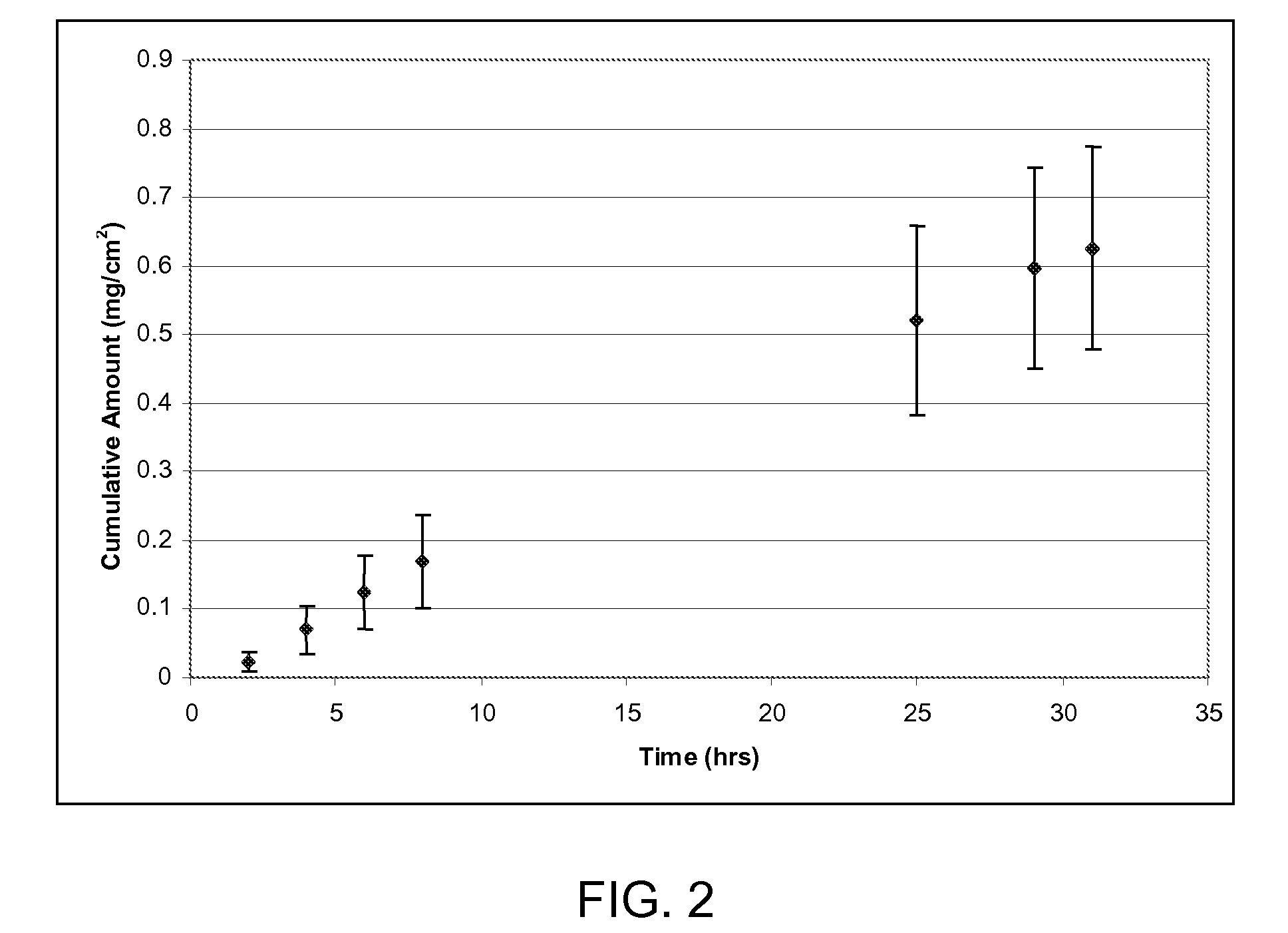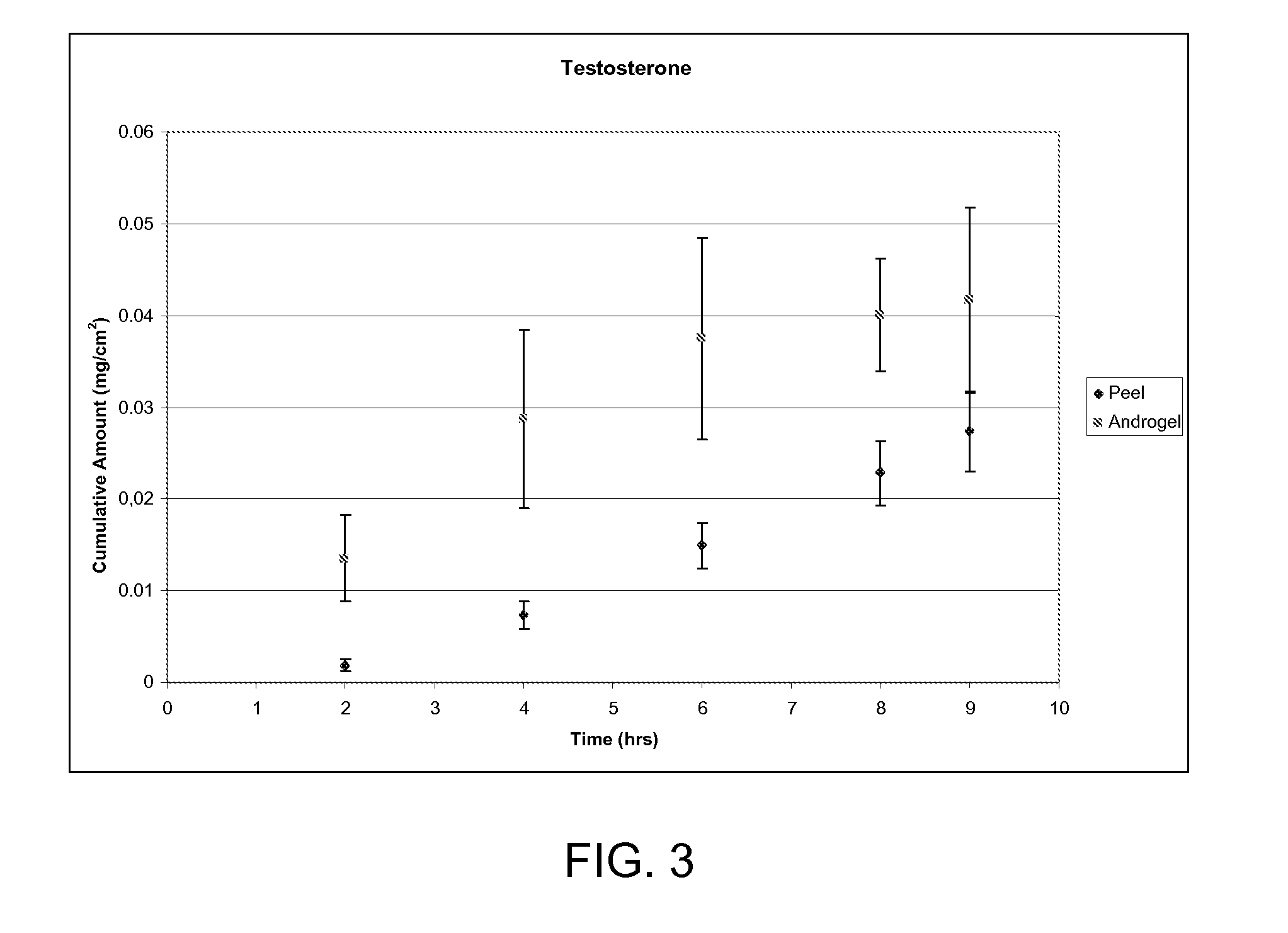Flux-enabling compositions and methods for dermal delivery of drugs
a composition and dermal technology, applied in the direction of drug compositions, ester active ingredients, amide active ingredients, etc., can solve the problems of not optimal for sustained-release applications, and achieve the effect of optimizing sustained drug delivery and being easy to remov
- Summary
- Abstract
- Description
- Claims
- Application Information
AI Technical Summary
Benefits of technology
Problems solved by technology
Method used
Image
Examples
example 1
[0119]Hairless mouse skin (HMS) or human epidermal membrane (HEM) is used as the model membranes as noted for the in vitro flux studies described in herein. Hairless mouse skin (HMS) is used as the model membrane for the in vitro flux studies described in herein. Freshly separated epidermis removed from the abdomen of a hairless mouse is mounted carefully between the donor and receiver chambers of a Franz diffusion cell. The receiver chamber is filled with pH 7.4 phosphate buffered saline (PBS). The experiment is initiated by placing test formulations (of Examples 2-5) on the stratum corneum (SC) of the skin sample. Franz cells are placed in a heating block maintained at 37° C. and the HMS temperature is maintained at 35° C. At predetermined time intervals, 8004 aliquots are withdrawn and replaced with fresh PBS solution. Skin flux (μg / cm2 / h) is determined from the steady-state slope of a plot of the cumulative amount of permeation versus time. It is to be noted that human cadaver s...
example 2
[0120]Human cadaver skin is used as membrane to select “flux-enabling” non-volatile solvent for betamethasone dipropionate. About 200 mcL of saturated solutions of BDP in various solvents are added to the donor compartment of the Franz cells. In vitro analysis as described in Example 1 is used to determine the steady state flux of BDP. In vitro methodology used is described in Example 1. Active enzymes in the skin convert betamethasone dipropionate to betamethasone. The steady state flux values reported in Table 1 are quantified using external betamethasone standards and are reported as amount of betamethasone permeating per unit area and time.
TABLE 1Non-volatile solvents for betamethasone dipropionateSkin Flux*Non-volatile solvent system(ng / cm2 / h)Propylene Glycol195.3 ± 68.5 Triacetin4.6 ± 2.8Light Mineral Oil11.2 ± 3.1 Oleic Acid8.8 ± 3.3Sorbitan Monolaurate30.0 ± 15.9Labrasol12.2 ± 6.0 *Skin flux measurements represent the mean and standard deviation of three determinations. Flux...
example 3
[0122]Formulations of clobetasol propionate in various non-volatile solvent systems are evaluated. All solvents have 0.1% (w / w) clobetasol propionate. The permeation of clobetasol from the test formulations through HEM is presented in Table 2 below.
TABLE 2Non volatile solvents for clobetasol propionateSkin Flux*Non-volatile solvent system(ng / cm2 / h)Propylene Glycol 3.8 ± 0.4Glycerol 7.0 ± 4.1Light Mineral Oil31.2 ± 3.4Isostearic Acid (ISA)19.4 ± 3.2Ethyl Oleate19.4 ± 1.6Olive Oil13.6 ± 3.3Propylene Glycol / ISA (9:1) 764.7 ± 193.9*Skin flux measurements represent the mean and standard deviation of three determinations. Flux measurements reported were determined from the linear region of the cumulative amount versus time plots. The linear region was observed to be between 6-28 hours. If the experiment was continued it is anticipated the steady state would continue.
Human cadaver skin is used as a membrane to select “flux-enabling” solvent for clobetasol propionate. In vitro methodology i...
PUM
| Property | Measurement | Unit |
|---|---|---|
| thickness | aaaaa | aaaaa |
| thickness | aaaaa | aaaaa |
| initial viscosity | aaaaa | aaaaa |
Abstract
Description
Claims
Application Information
 Login to View More
Login to View More - R&D
- Intellectual Property
- Life Sciences
- Materials
- Tech Scout
- Unparalleled Data Quality
- Higher Quality Content
- 60% Fewer Hallucinations
Browse by: Latest US Patents, China's latest patents, Technical Efficacy Thesaurus, Application Domain, Technology Topic, Popular Technical Reports.
© 2025 PatSnap. All rights reserved.Legal|Privacy policy|Modern Slavery Act Transparency Statement|Sitemap|About US| Contact US: help@patsnap.com



